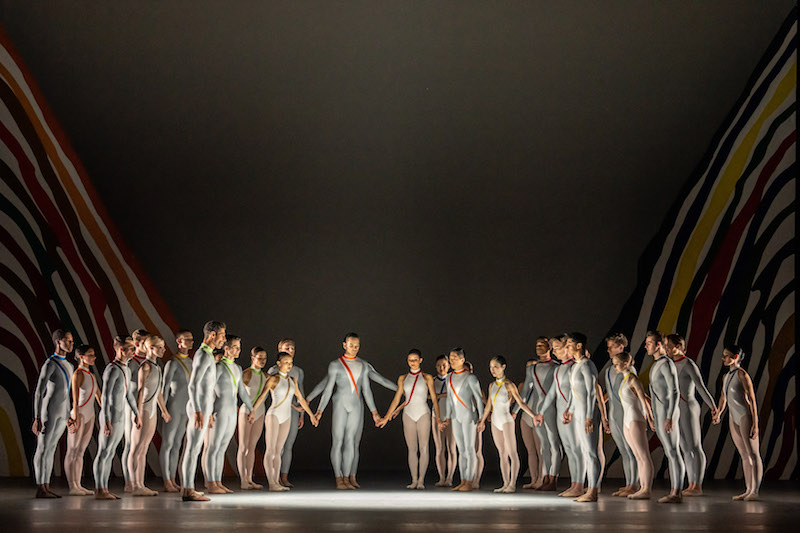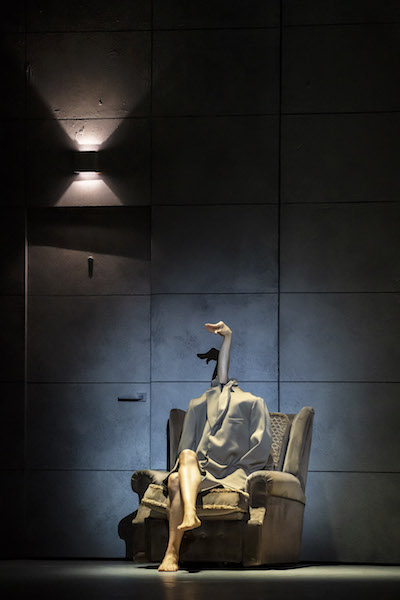Carlos Acosta’s idea of putting live music first and foremost in BRB’s latest mixed bill was a no-brainer. The Midlands-based company, directed by Acosta since early 2020, is unique among British ballet companies in being able to call on its own full-time orchestra (the Royal Ballet has to share theirs with the Opera), and it happens to be a first-class band.
So the prospect of Britten and Beethoven forming meaty chunks in the typical three-ballet sandwich promised a feast – on the aural front at least – in an evening entitled Into the Music, to which an appropriate response might be “Who wouldn't be, when music's as good as this?”
Jiri Kylian’s fiercely expressive Forgotten Land was the opener, driven by the drama of Benjamin Britten’s Sinfonia da Requiem (not to be confused with his War Requiem), written in the dark days of 1940. Cast in two sombre outer movements and an agitated middle, the piece covers a gamut of moods, from innocence to regret, anger and despair, with gusting eruptions of percussion and brass which made one fear for the eardrums of those in the cramped Sadler's Wells pit – for this is music for very large forces, cleanly corralled on this occasion by conductor Thomas Jung. The choreography matches these moods in a series of wildly contrasting duets for six couples (pictured below), and throughout there is a sense of life lived on the edge, its future uncertain, the fight for continuance intense. At times, when two dancers run at each other at a furious lick to leap into the others’ arms, you find yourself flinching. The dancers of BRB don’t hold back. A vast, wild seascape by the British painter John Macfarlane provides a fittingly glowering backdrop. Just as much of a musical treat was to hear the Seventh Symphony of Beethoven, one of few classical symphonies to have been adopted as a ballet score multiple times with some success, no doubt because of the bounding rhythms that dance through it. Not for nothing did Richard Wagner call this symphony “the apotheosis of the Dance”: from the first note to the last, it's all about rhythm, even in its funeral march. Even so, nothing could have prepared us for the joyous blast of Uwe Scholz’s turn-of-the-millennium response to this most hummable of scores.
Just as much of a musical treat was to hear the Seventh Symphony of Beethoven, one of few classical symphonies to have been adopted as a ballet score multiple times with some success, no doubt because of the bounding rhythms that dance through it. Not for nothing did Richard Wagner call this symphony “the apotheosis of the Dance”: from the first note to the last, it's all about rhythm, even in its funeral march. Even so, nothing could have prepared us for the joyous blast of Uwe Scholz’s turn-of-the-millennium response to this most hummable of scores.
The German choreographer’s work is unaccountably unknown in the UK (he was prolific but died horribly young, three years after making this piece). Kudos to Carlos Acosta for correcting our ignorance, and for believing that his dancers at Birmingham Royal Ballet could do the work justice, for its steps are fiendishly demanding. In movement style it owes much to Balanchine (think of that choreographer’s Symphony in C, a regular party-piece for BRB's sister company in London). But Scholz’s visualisation of the score in The Seventh Symphony is too fizzingly inventive for such comparisons to hold. Using almost entirely classical steps, he keeps us in a state of breathless suspense, trying to guess when and where the next stream of leaping bodies will spring from. Satisfyingly, though, Scholz bows to every one of Beethoven's repeats, showing us the same steps to the same music – a welcome chance to take in the deliciously nuanced detail (main picture) that one misses first time round. It's impressive that BRB now has the talent and polish across the company – not just among its principals – to stand up to such scrutiny. Several images remain imprinted on the brain long after: the men dragging their partners across the floor like sacks of grain, or carrying them as planks above their heads. Perhaps the most mysterious comes in the symphony's third movement (pictured above), when the entire cast join hands and lean in to a wide pool of light on the floor, remaining motionless while the music races on. Are they peering into the Sun? An abyss? The afterlife? Whatever, it's a telling hiatus, and it comes twice. How amusing, then, to read that this was originally merely a choreographer's desperate solution to running behind schedule. But this is wonderful stuff. Here's hoping that the large number of ballet directors who turned out for this show's opening night will have gone straight home to check out the Scholz catalogue and eventually bring us more.
Several images remain imprinted on the brain long after: the men dragging their partners across the floor like sacks of grain, or carrying them as planks above their heads. Perhaps the most mysterious comes in the symphony's third movement (pictured above), when the entire cast join hands and lean in to a wide pool of light on the floor, remaining motionless while the music races on. Are they peering into the Sun? An abyss? The afterlife? Whatever, it's a telling hiatus, and it comes twice. How amusing, then, to read that this was originally merely a choreographer's desperate solution to running behind schedule. But this is wonderful stuff. Here's hoping that the large number of ballet directors who turned out for this show's opening night will have gone straight home to check out the Scholz catalogue and eventually bring us more.
 The new work on the programme, Hotel, took us to a very different place, including a reception desk and a dining-room. Its creator duo, Morgann Runacre-Temple and Jessica Wright, integrate film into all their work, and here that extends to real-time footage of the action, filmed by the dancers as we watch. The mood is distinctly whacky – Wes Anderson visits Fawlty Towers – and there is a story, some bad business between the chef and the hotel manager resulting in hallucinogenic mashed potato. Much of the comedy works a treat (pictured right). At other times, the eye is too confused by projections on walls to know where to look, and the live close-ups are murky. Overall, there could be more dance, less business, though a leaping pas de trois for bellhops is a delight. And the standout image of the emu (ostrich? goose?) created simply by a shrouded dancer extending one bare arm, the hand forming a beak, is a real comic coup. Mikael Karlsson's score is eclectic and jittery, apparently spooking some members of the orchestra, whose entries weren't all as clean as usual.
The new work on the programme, Hotel, took us to a very different place, including a reception desk and a dining-room. Its creator duo, Morgann Runacre-Temple and Jessica Wright, integrate film into all their work, and here that extends to real-time footage of the action, filmed by the dancers as we watch. The mood is distinctly whacky – Wes Anderson visits Fawlty Towers – and there is a story, some bad business between the chef and the hotel manager resulting in hallucinogenic mashed potato. Much of the comedy works a treat (pictured right). At other times, the eye is too confused by projections on walls to know where to look, and the live close-ups are murky. Overall, there could be more dance, less business, though a leaping pas de trois for bellhops is a delight. And the standout image of the emu (ostrich? goose?) created simply by a shrouded dancer extending one bare arm, the hand forming a beak, is a real comic coup. Mikael Karlsson's score is eclectic and jittery, apparently spooking some members of the orchestra, whose entries weren't all as clean as usual.
But this is an exciting programme, overall, as we're learning to expect from the new Birmingham regime. And certainly its most ambitious to date.














Add comment